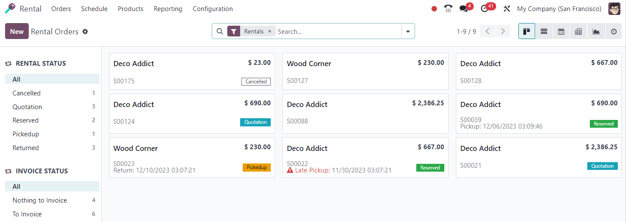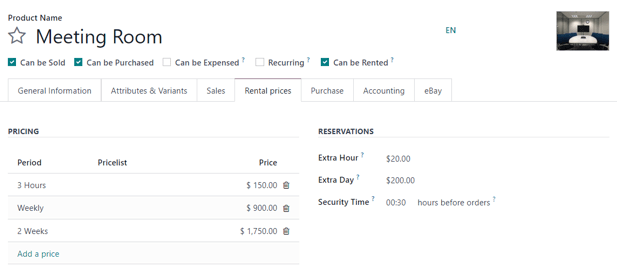Rental¶
The Odoo Rental application provides comprehensive solutions to configure and manage rentals.
Send quotations, confirm orders, schedule rentals, register products when they are picked up and returned, and invoice customers from this single platform.
Dashboard¶
Upon opening the Rental application, the Rental Orders dashboard is revealed.

In the default Kanban view, all rentals are visible. Each rental card displays the customer name, the price of the rental, the related sales order number, along with the status of the rental.
On the left sidebar, the Rental Status for each rental can be found. Beneath that, the Invoice Status of the rentals is accessible. Clicking any option in the left sidebar filters the displayed rentals on the dashboard.
Settings¶
To configure additional rental delay costs, availability of rental items, or minimum time of rental, navigate to .

In the Rental section, there are options to configure Default Delay Costs and Default Padding Time. Also, there is the option to activate Rental Transfers.
Default Delay Costs are additional costs for late returns.
Default Padding Time represents the minimum amount of time between two rentals.
Rental Transfers means stock deliveries and receipts can be used for rental orders.
In the Rent Online section, there are options to configure a Minimal Rental Duration and designate Unavailability days, or days during which pickup and return are not possible.
Rental products¶
To view all products that can rented in the database, navigate to . By default, the Rental search filter appears in the search bar.
Each product Kanban card displays that product’s name, rental price, and product image (if applicable).
See also
Rental pricing¶
To adjust the rental pricing on a product, go to the Products page in the Rental app, then select the desired product or click New to create a new product from scratch.
On the product form, ensure the Rental checkbox is ticked. Then, open the Rental prices tab.

Pricing¶
Under the Pricing section of the Rental prices tab, designate custom rental prices and rental periods for the product.
To add pricing for a rental, click Add a price. Then, choose a pricing period (the unit of duration of the rental) in the Period column, or create a new pricing period by typing in the name and clicking Create.
Next, decide whether or not to apply this custom rental price to a specific Pricelist.
Lastly, enter the desired Price for that specific Period.
Note
No limit exists on how many pricing lines can be added. Multiple pricing options for rental products are typically used to give discounts for customers who agree to longer rental durations.
Note
Remember when considering pricing that renting for a day is usually limited to operating hours, not 24 hours. When determining pricing, keep in mind that a rental day typically refers to operating hours, not a full 24-hour period.
Reservations¶
Under the Reservations section of the Rental prices tab, there is the option to configure additional fines for any Hourly Fine or Daily Fine that the customer takes to return a rental.
Also, there is the option to set the Reserve product time, expressed in hours, to make the rental product temporarily unavailable between two rental orders. Such a feature may prove useful if maintenance or cleaning is required between rentals.
Price computing¶
Odoo always uses two rules to compute the price of a product when a rental order is created:
Only one price line is used.
The cheapest line is selected.
Exercise
Consider the following rental pricing configuration for a product:
1 day: $100
3 days: $250
1 week: $500
A customer wants to rent this product for eight days. What price will they pay?
After an order is created, Odoo selects the second line as this is the cheapest option. The customer has to pay three times ‘3 days’ to cover the rental’s eight days, for a total of $750.